When my neighbor Mrs. Lane came home after surgery, she felt worried about one thing: staying connected to her care team between visits. A nurse showed her an easy cuff and an ECG patch that sent readings straight to her clinic. That small loop of information made her feel safer and less alone.
This guide is your friendly map to practical tools you can use today. We’ll explain how readings move from simple gadgets to apps and clinician dashboards, and why that flow matters for real decisions. Expect clear comparisons of consumer favorites and clinical-grade options.
Interoperability is changing the game. New standards help multi-vendor gear work together, cutting integration headaches for providers and patients. Choose tools that match your goals, budget, and support network so tracking fits daily life without extra complexity.
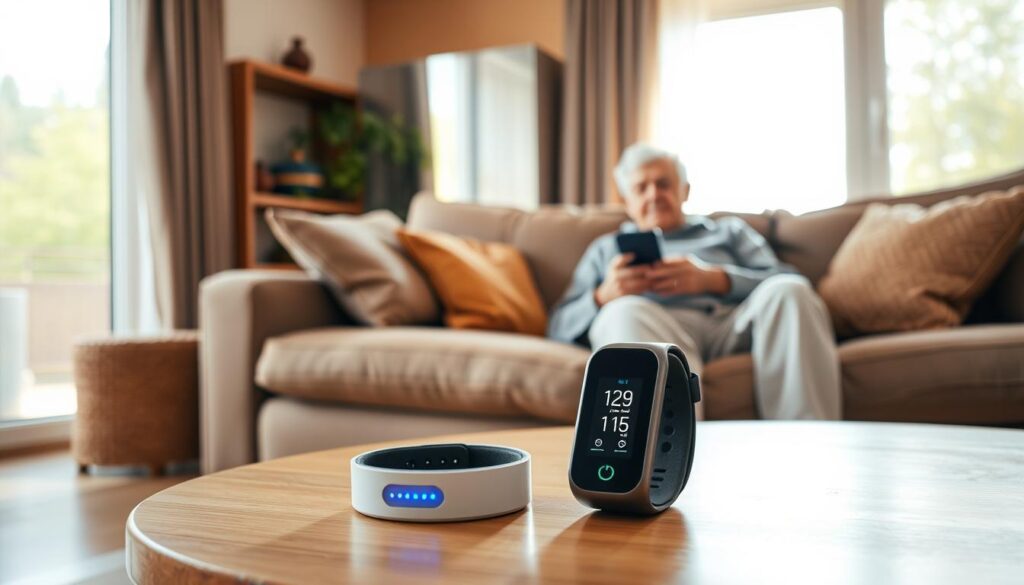
Key Takeaways
- This guide helps patients compare trusted home solutions and clinical options.
- Learn how readings flow to apps and clinician dashboards and why it matters.
- Interoperability and new standards make multi-vendor setups easier.
- Pick tools that match your condition, goals, budget, and care team.
- Accurate, reliable gear with strong apps makes daily tracking stick.
Why Bluetooth Health Monitoring Matters for Home Care Today
Continuous at‑home measures put meaningful clinical signals in front of care teams every day. That steady stream of information lets providers spot early warning signs and prevent avoidable escalations between visits.
Real‑time data gives a fuller picture than one‑time clinic snapshots. Connected tools capture blood pressure, glucose, oxygen, temperature, weight, and ECG traces so clinicians can act on trends instead of guesses.
How remote patient monitoring improves outcomes and reduces visits
When out‑of‑range readings trigger alerts, care teams review trends and adjust treatment quickly. This can cut unnecessary ER trips and lower clinic load while improving clinical outcomes.
From daily engagement to proactive care decisions
Daily self‑checks help patients see patterns and stick to plans. In real‑world programs, sustained engagement links to better blood pressure and glucose control and fewer complications.
- Provider workflows: alerts, trend review, and medication titration based on ongoing data.
- Patient convenience: less travel, timely advice, and clearer recovery goals.
- Program success: clear thresholds, education, and feedback loops build trust and adherence.
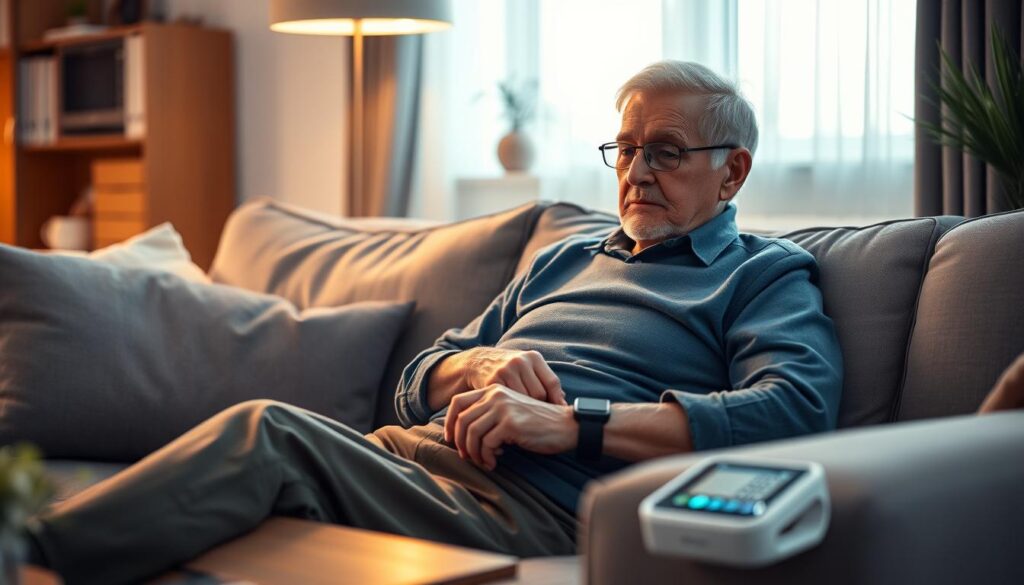
Ask your clinician about eligibility in local programs today — secure, person‑centered monitoring can expand access and improve outcomes while protecting privacy and clinical capacity.
Understanding Remote Patient Monitoring and Connected Health
Routine measurements at home turn isolated numbers into trends clinicians can act on.
What signals are captured? Common sensors track blood pressure, heart rate, glucose (fingerstick and continuous), oxygen saturation, temperature, weight, ECG, and activity or sleep. Each reading supports clinical decisions — trends guide medication changes, and spikes prompt timely contact.
Typical data flow is simple: a sensor transmits to a phone or hub, encrypted sync moves information to cloud services, and providers access that stream via portals or EHR integration. Metadata like time stamps, device IDs, and calibration notes make the record reliable.
- Spot checks (e.g., fingerstick glucometers) give point-in-time values.
- Continuous sensors (e.g., CGMs, ECG patches) reveal trends and variability.
- Alerts are set by thresholds so patients and clinicians know when to retest or schedule a televisit.
| Aspect | Spot-Check | Continuous |
|---|---|---|
| Typical use | Routine tests several times daily | Ongoing streams, minutes to minutes |
| Best for | Quick verification | Trend analysis and alerts |
| Data path | Phone → cloud → portal | Phone/hub → encrypted cloud → EHR |
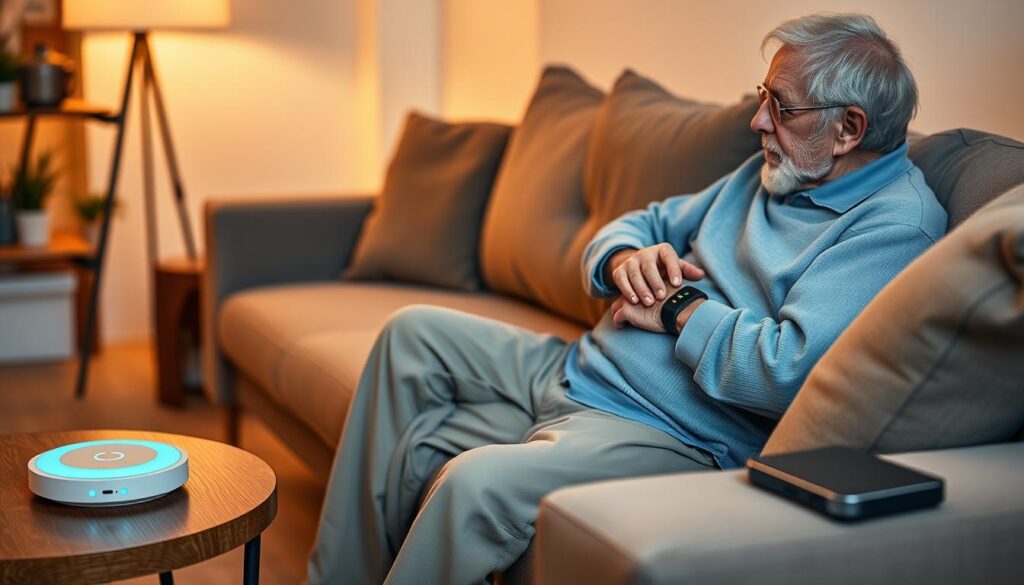
New Interoperability Standards: Bluetooth GHS and Multi‑Vendor RPM
A common data language for sensors is making vendor choice simpler and faster.
The Generic Health Sensor (GHS) Profile defines how personal sensors package and transmit sensor data reliably so readings flow into clinical systems used in remote patient monitoring.
Previously, EHR vendors often built custom integrations for each maker. That created fragmentation, slowed program delivery, and limited which devices clinics could adopt.
GHS unlocks a multi‑vendor ecosystem. Organizations can mix and match equipment across programs while keeping consistent payloads and semantics. That improves downstream analytics and clinical decision support.
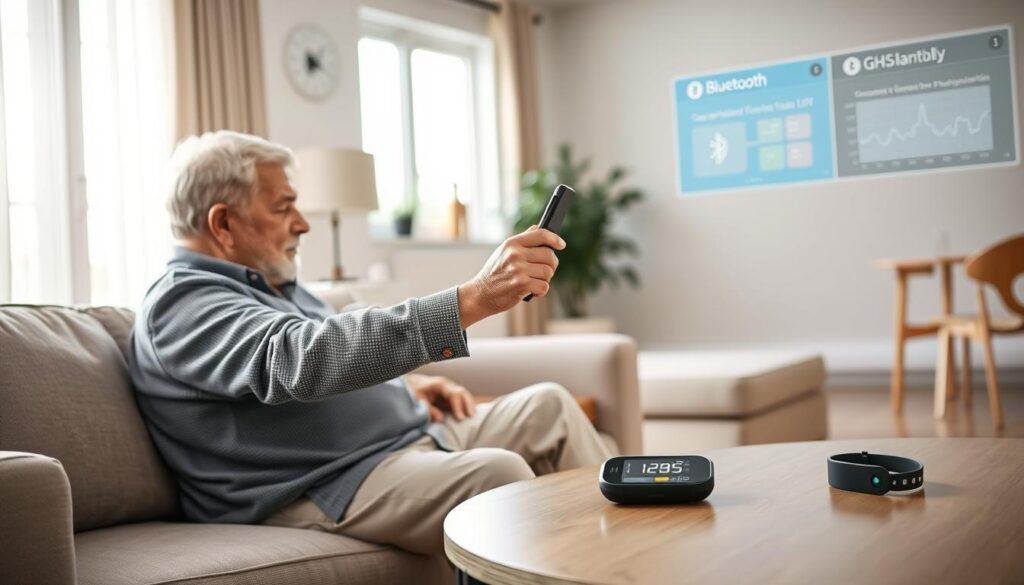
Practical benefits
- Providers reduce onboarding friction and see faster time to value.
- EHR vendors avoid bespoke interfaces and lower integration costs.
- Device makers speed development by targeting one common profile.
- Patients gain broader choices that just work together.
Industry leaders like Philips and Roche contributed to the profile, signaling real momentum behind multi‑vendor integration. GHS also complements FHIR/HL7 on the provider side, creating an end‑to‑end pipeline from sensor to chart.
Tip: When evaluating new rpm kits, ask vendors about GHS support to future‑proof program delivery and reduce pairing problems.
How to Choose the Right Bluetooth Health Monitoring Systems
Picking the right connected kit starts by matching clinical needs with everyday habits.
Key factors: accuracy, connectivity, app experience, and support
Start with validation. Verify clinical validation and published accuracy, especially when readings will inform management or medication changes.
Compare sync options like auto‑sync or cellular hubs. Test the app for reminders, clear graphs, and simple tracking flows.
Assess durability, battery life, sensor fit, and replacement supplies. Check vendor support and warranty before you buy.
Privacy, data sharing, and integration with provider dashboards
Confirm who sees your data, how long information is stored, and whether sharing settings are adjustable.
Ask providers about dashboard compatibility. Choose equipment that uploads in real time to clinician portals and EHRs to avoid manual entry.
“Choose tools that your care team can access easily and that you will use every day.”
| Factor | What to check | Why it matters |
|---|---|---|
| Accuracy | Clinical validation, user reviews | Guides safe management decisions |
| Connectivity | Auto‑sync, hubs, GHS support | Saves time and reduces data gaps |
| Cost & access | Device price, consumables, coverage | Impacts long‑term adherence |
| Accessibility | Large fonts, voice prompts, simple UI | Helps patient confidence and daily use |
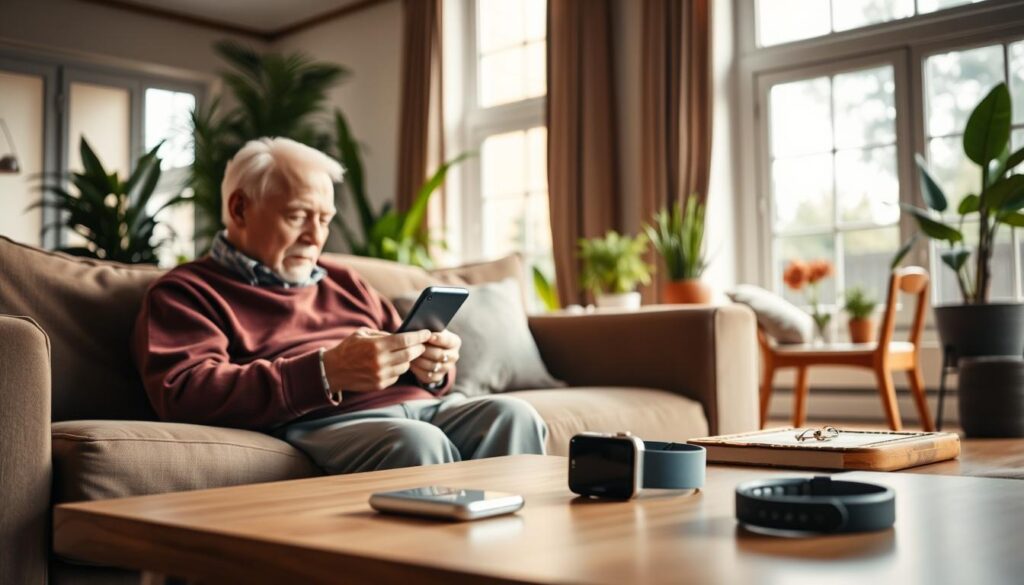
Top Bluetooth Blood Pressure Monitors for Hypertension Management
Home blood pressure tracking reveals patterns a single clinic visit can miss. Regular readings show true trends and help avoid one-off errors when clinicians set treatment plans.
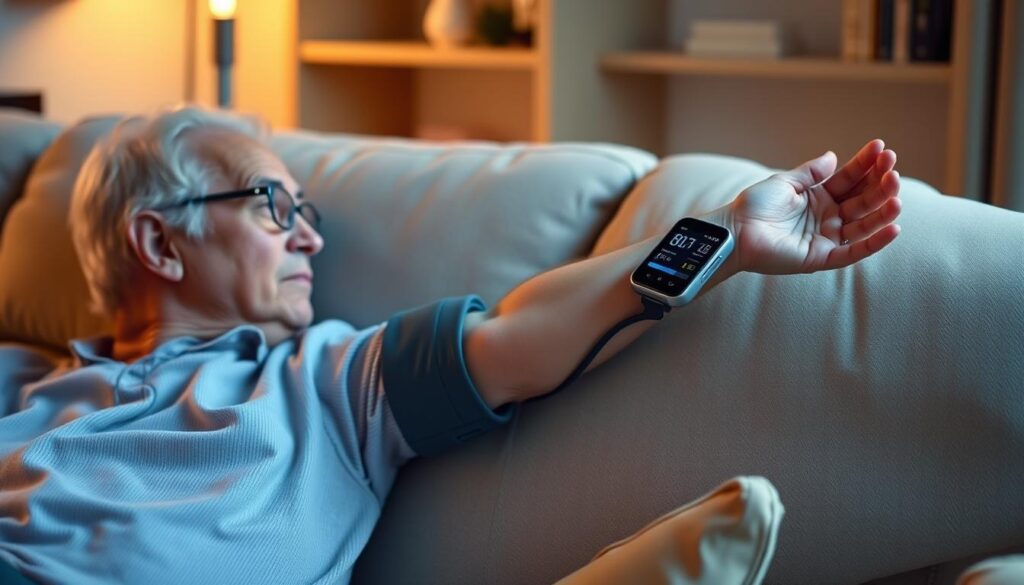
Why daily blood pressure tracking beats one‑time readings
Daily checks reduce surprises. They catch white coat spikes and masked hypertension that a clinic visit can miss. That matters because sustained pressure control links to better outcomes in hypertension, diabetes, CHF, and kidney disease.
Features to prioritize: cuff fit, validation, and trend alerts
- Validation: pick cuffs listed under recognized protocols for proven accuracy.
- Cuff fit: correct size and snug placement matter more than brand.
- Apps & alerts: reliable apps auto‑upload data so providers can view trends and adjust medication safely.
- Practical checks: battery life, travel case, multi‑user profiles, and periodic clinic comparisons keep readings trustworthy.
“Use multiple seated readings at the same time each day and share rolling averages with your clinician.”
Best Bluetooth Glucose and Continuous Blood Sugar Trackers
Some people need quick spot checks, while others benefit from a steady stream of glucose trends.
Glucometers read a drop of blood on a test strip and give on‑demand blood glucose results that can sync to apps and to providers in real time.
Continuous glucose monitors (CGMs) stream minute‑by‑minute glucose trends, offer high/low alerts, and increasingly integrate with insulin pumps and smartphone apps.
Glucometers vs. CGMs: picking the right diabetes solution
Use fingerstick meters for budget‑friendly spot checks and for patients who test a few times daily.
Choose CGMs when you need trend arrows, time‑in‑range, and automatic alerts to reduce hypoglycemia risk and support tighter medication titration.
- How they help: both approaches let patients and providers correlate meals, exercise, stress, and illness with blood sugar changes.
- Practical factors: sensor wear time, calibration, insurance coverage, and pump integration matter.
- App features to prioritize: sharable reports, meal tagging, trend arrows, and time‑in‑range summaries.
Learn pattern interpretation with your care team, confirm meter accuracy against lab values, and pick tools that fit sleep, sport, and sensitivity to adhesives.
Wearable Bluetooth Picks: Smartwatches, ECG Patches, and Fitness Bands
Modern wrist trackers and patches turn daily rhythms into clear signals clinicians can act on. Smartwatches like Apple Watch and Fitbit log steps, heart rate, spot ECGs, HRV, stress scores, and sleep stages. Quick glances at these summaries help patients adjust activity and share trends with their care team.
Heart rate, ECG, HRV, stress, and sleep insights at a glance
Wellness bands surface resting heart, trends during exercise, and sleep staging that can reveal poor recovery or sleep fragmentation. Shareable reports from Apple Health, Fitbit, or Google make patterns visible to clinicians.
When to choose clinical‑grade ECG monitoring
Continuous ECG patches record 24–72 hours and are the right choice when palpitations, syncope, or suspected AFib need investigation. They provide higher-fidelity traces that support diagnostic workflows in formal rpm programs.
Activity and recovery metrics that support chronic care
VO2 max, recovery scores, and step trends help shape cardiac rehab, diabetes plans, and post‑surgery pacing. Accessories like chest straps or external sensors boost training accuracy during clinic‑guided programs.
- Know the difference: consumer wellness versus medical‑grade clearance and how each fits clinical pathways.
- Prioritize comfort, battery life, and adhesive tolerance to improve adherence.
- Use AI coaching features cautiously; they flag signals but do not replace clinician judgment.
“Sync wearables with remote patient programs so data flows into clinician portals, not just consumer apps.”
Essential RPM Devices for Oxygen, Temperature, and Weight
Small, connected tools can spot early changes in breathing and body signs before a clinic visit.
Pulse oximeters with connectivity
Connected pulse oximeters measure blood oxygen and pulse to help patients and providers watch oxygen levels and pulse trends in COPD, CHF, pneumonia, asthma, and post‑COVID recovery.
Trend charts reveal slow declines in lung function and can trigger earlier outreach when saturation drops or symptoms worsen.
Smart thermometers
Smart thermometers log fevers and symptom notes so families and clinicians see patterns during flu season or other infections.
They speed triage and support clear escalation when fever pairs with breathing or other concerning signs.
Bluetooth scales and weight tracking
Scales matter in CHF and metabolic management. Daily weight checks catch sudden gains that suggest fluid retention and need prompt treatment adjustment.
Consistent morning readings, stable platforms, and multi‑user profiles boost reliability and long‑term weight goals.
“Pair these tools with clinician dashboards so alerts become actionable, not just stored on a phone.”
| Tool | Primary measure | When to escalate |
|---|---|---|
| Pulse oximeter | Oxygen saturation, pulse | Saturation |
| Smart thermometer | Temperature, fever trends | High fever with respiratory symptoms |
| Connected scale | Weight | Rapid gain >2–3 lbs/day or 5 lbs/week |
Keep hygiene, battery checks, and calibration top of mind so readings stay accurate. Ask your care team about device‑specific thresholds to guide timely care and better cardiometabolic management.
Integrating Devices with RPM Programs and EHRs in the United States
A clear data path makes remote measurements useful at the point of care.
Map the flow: device pairing, secure mobile app capture, encrypted cloud sync, and structured delivery into clinician portals and EHRs. This chain turns raw readings into usable information that clinic teams can act on.
Standards matter. FHIR and HL7 links allow real‑time alerts, documentation, and workflow automation between programs and provider systems. The GHS profile standardizes sensor payloads so makers and providers avoid bespoke interfaces and reduce pairing faults.
Practical onboarding: create accounts, collect consent, link the device, and teach simple pairing steps. Train patients and staff to keep gear online and to resolve common pairing messages.
- Define who reviews dashboards, how often, and escalation paths when thresholds trigger.
- Enforce HIPAA: data segregation, audit trails, and least‑privilege access for care teams.
- Pick vendors with proven EHR integrations, clear APIs, and uptime SLAs to ensure steady delivery.
When integration works, providers spend less time on manual entry and more time on care. Periodic integration testing after app or EHR updates prevents silent data drop‑offs and protects long‑term program success.
Trends Shaping Home Monitoring Today
Everyday tools are becoming meaningful sources of clinical information. Demand for connected tech is rising fast through 2025 as care shifts beyond clinic walls. That movement changes how patients, clinicians, and programs work together.
Patient empowerment and AI insights
Apps and simple interfaces make data entry and review easy. Patients get clear summaries and nudges that support daily habits. AI then highlights trends, flags concerning patterns, and reduces the need for manual review.
Why this matters: surfaced insights speed treatment decisions and help patients act earlier on worsening disease.
Telehealth‑ready exam kits
Bundled kits now include digital stethoscopes, otoscopes, and thermometers to improve virtual exams. These kits raise exam quality and let clinicians confirm findings without travel.
Smart inhalers, hearing aids, and sleep tools
Smart inhalers track adherence and technique, which lowers exacerbations in asthma and COPD and supports better treatment plans.
Connected hearing aids use AI amplification and streaming to adapt to environments and improve daily engagement.
AI sleep trackers link sleep patterns to cardiometabolic disease risk, mood, and recovery. Sleep insights help shape holistic care plans.
Home ECG kits and emerging lenses
Portable ECG kits now offer expanded leads for follow‑up checks. They reduce travel and speed access to cardiac evaluation.
Emerging smart contact lenses aim to monitor intraocular pressure or glucose, promising earlier detection and more personalized disease management.
| Trend | Benefit | Clinical impact |
|---|---|---|
| AI-driven summaries | Faster insight from routine readings | Quicker treatment changes and fewer missed alarms |
| Telehealth kits | Higher quality virtual exams | Better triage and fewer unnecessary visits |
| Adherence tech (inhalers) | Improved medication technique | Reduced exacerbations and ER visits |
| Sleep & lens innovation | New physiologic signals | Earlier disease detection and tailored treatment |
“Innovation is rapid, but clinical validation and clear pathways to treatment remain essential.”
Standards like the GHS profile lower integration barriers and help novel tools join established programs. Patients and providers should review their mix periodically as evidence and capabilities evolve.
Conclusion
Bringing routine measurements into daily life gives each patient and their care team a clearer, day‑to‑day view. Simple, repeatable checks at home turn isolated numbers into meaningful trends that guide action.
Consistent monitoring helps patients avoid surprises. Timely signals can improve outcomes and reduce unplanned visits by prompting early outreach.
Interoperability matters. Standards like the Bluetooth SIG’s GHS profile make multi‑vendor integration simpler today and help EHRs receive structured data more reliably.
Pick tools you will use and align them with your provider’s program. Start with one priority measure, build a routine, then add more items slowly to avoid overwhelm.
Data has value only when it informs care. Discuss thresholds, trends, and next steps with your clinician, and revisit options as innovation advances. Thank you for reading — explore the categories above to find the best fit for your situation.
FAQ
What kinds of vital signs and metrics do modern connected monitoring devices track?
Today’s connected tools commonly track blood pressure, heart rate and rhythm (including ECG), blood glucose and continuous glucose trends, SpO2 (oxygen), body weight, temperature, respiratory data, sleep metrics, and activity. Many also record medication adherence and symptom reports to support chronic conditions like diabetes, hypertension, COPD, and heart failure.
How does remote patient monitoring improve outcomes and reduce clinic visits?
Continuous or scheduled data transmissions enable early detection of worsening trends so clinicians can intervene before an emergency. That proactive approach reduces unnecessary office visits and hospital readmissions while supporting personalized care plans and timely medication adjustments.
What should I look for when choosing a device for blood pressure or glucose tracking?
Prioritize clinical validation, proper cuff sizing for blood pressure, sensor accuracy for glucose devices, ease of use, and reliable mobile apps. Also check data export or integration options so results can flow into clinician dashboards or electronic health records for coordinated care.
How is patient data transmitted to providers and integrated with EHRs?
Devices typically pair with smartphone apps that encrypt and upload data to cloud platforms. Those platforms use standards like FHIR or HL7 to share data with EHRs and clinician portals. Interoperability lets care teams view trends and incorporate measurements into care programs.
What is the Bluetooth Generic Health Sensor (GHS) profile and why does it matter?
The GHS profile standardizes how physiological sensors present measurements and metadata to connecting apps. That standard reduces fragmentation, enabling multi‑vendor ecosystems where patient devices can reliably pair with apps and RPM platforms from different makers.
Are wearable ECG patches and smartwatches accurate enough for clinical use?
Consumer smartwatches provide useful screening for heart rate and irregular rhythms, while clinical‑grade wearable ECG patches and prescribed ambulatory monitors deliver diagnostic‑level ECG data. Choose devices validated for the intended clinical purpose and check whether clinicians accept their data.
How secure is remote monitoring data and what about patient privacy?
Reputable vendors encrypt data in transit and at rest, follow HIPAA requirements, and provide consent workflows for data sharing. When selecting products, review vendor privacy policies, data retention practices, and whether the platform supports role‑based access for care teams.
Can RPM devices alert clinicians in real time for urgent issues?
Many platforms offer configurable alerts for out‑of‑range readings and can route notifications to clinicians or care coordinators. However, alert rules vary; confirm how escalations, false‑positive handling, and clinician workflows are managed before deploying a program.
Do scales, pulse oximeters, and thermometers work well with chronic disease programs?
Yes. Connected scales help manage fluid status in heart failure, pulse oximeters support COPD and post‑COVID care, and smart thermometers help detect infection trends. Integration with RPM platforms enables trend analysis and actionable thresholds tied to care pathways.
How easy is it for older adults or nontechnical patients to use these devices?
Ease of use depends on device design, app simplicity, and program support. Look for one‑step pairing, automatic uploads, clear on‑device instructions, and caregiver or clinician support options. Many RPM programs include onboarding and tech help to boost adherence.
What role do APIs, FHIR, and HL7 play in device integration?
APIs and standards like FHIR and HL7 enable data exchange between device platforms, EHRs, and care management tools. They help clinicians access structured measurements, support clinical decision support, and streamline documentation for billing and population health.
How do I ensure device accuracy and clinical validation claims?
Verify peer‑reviewed studies, FDA clearance where applicable, and independent validation against clinical reference methods. Check manufacturer data, regulatory clearances, and professional society recommendations for the device class you plan to use.
Can RPM data reduce costs for providers and payers?
When implemented with clear protocols and billing workflows, RPM programs can lower hospitalizations and emergency visits, improve medication management, and support preventive care — all of which can reduce overall costs and improve outcomes.
What emerging trends should clinicians watch in home monitoring?
Watch AI‑driven trend analysis, tighter EHR integration, device interoperability across vendors, telehealth‑ready exam kits, and new connected sensors such as smart inhalers and hearing devices that broaden chronic care management options.
Transform Your IoT Vision Into Reality.
Get free expert insights, architectures & cost breakdowns.
Drop your email to schedule free meeting.